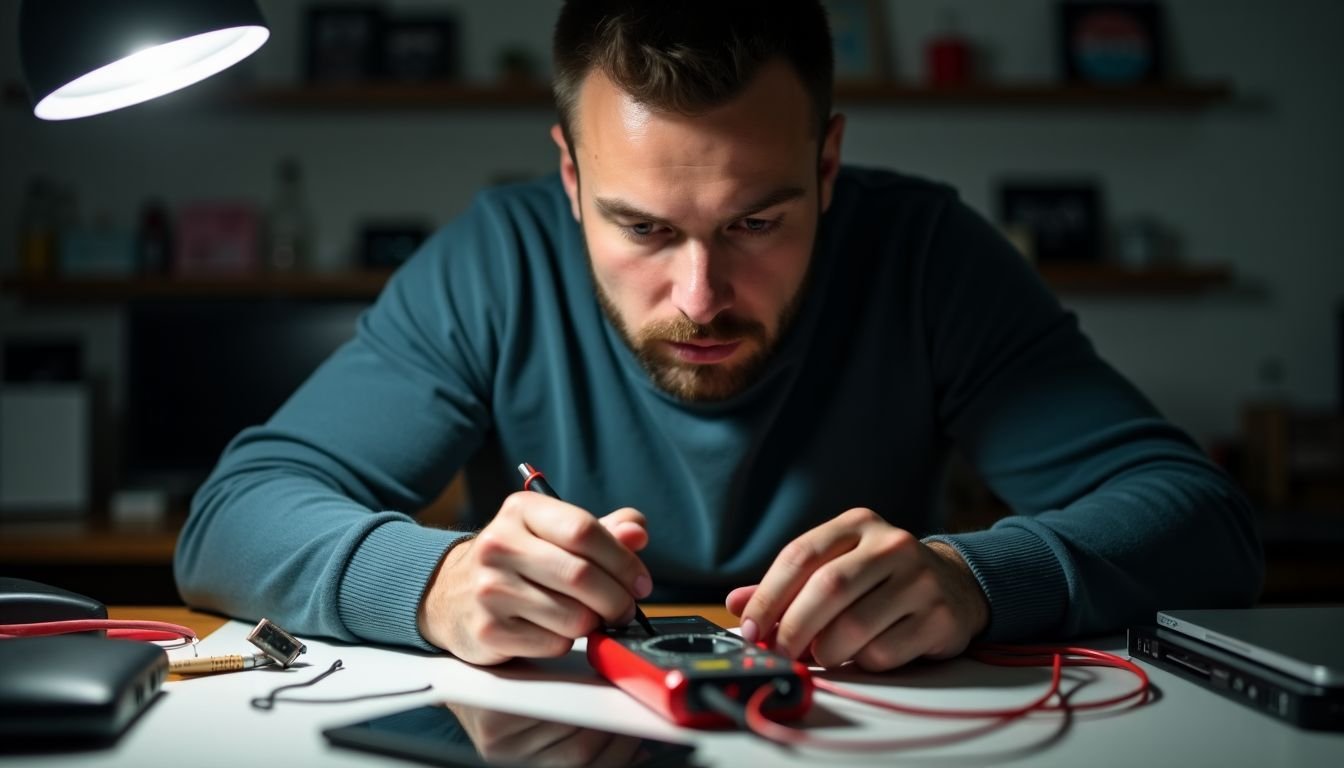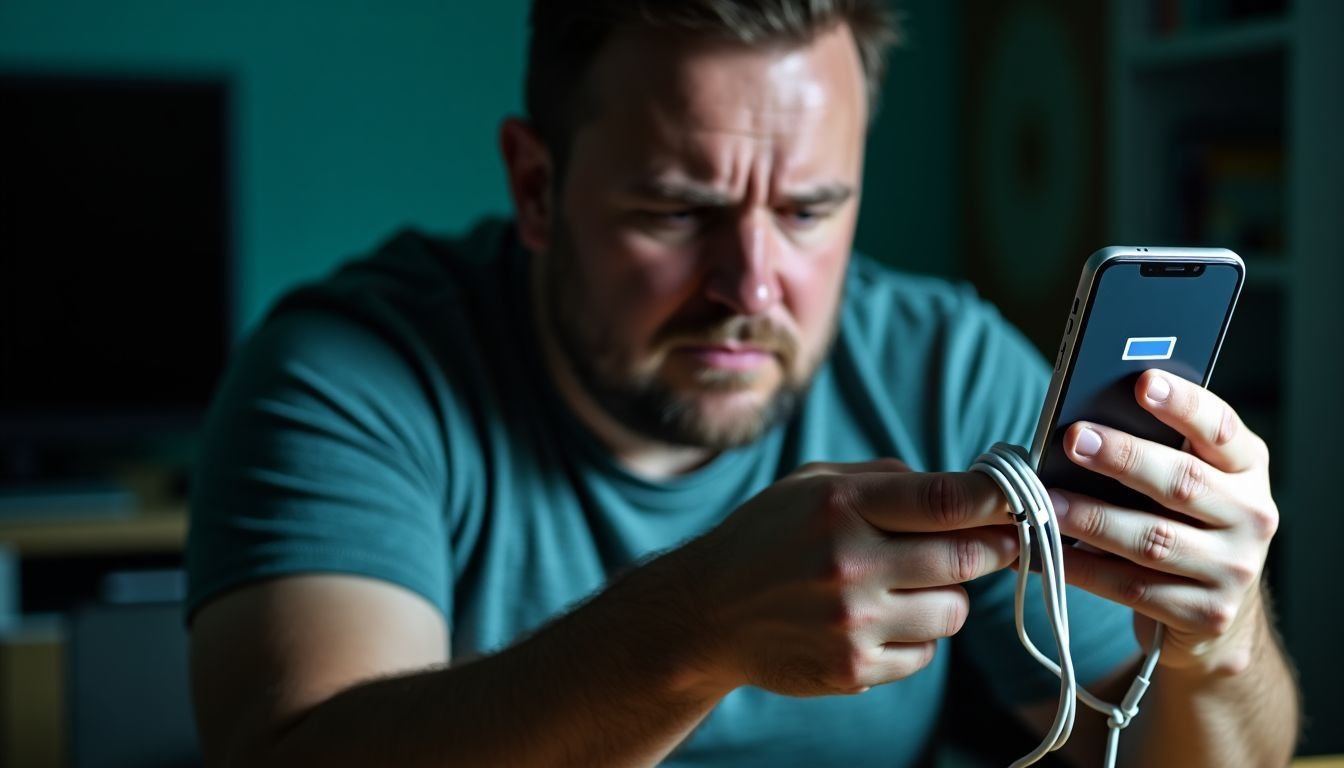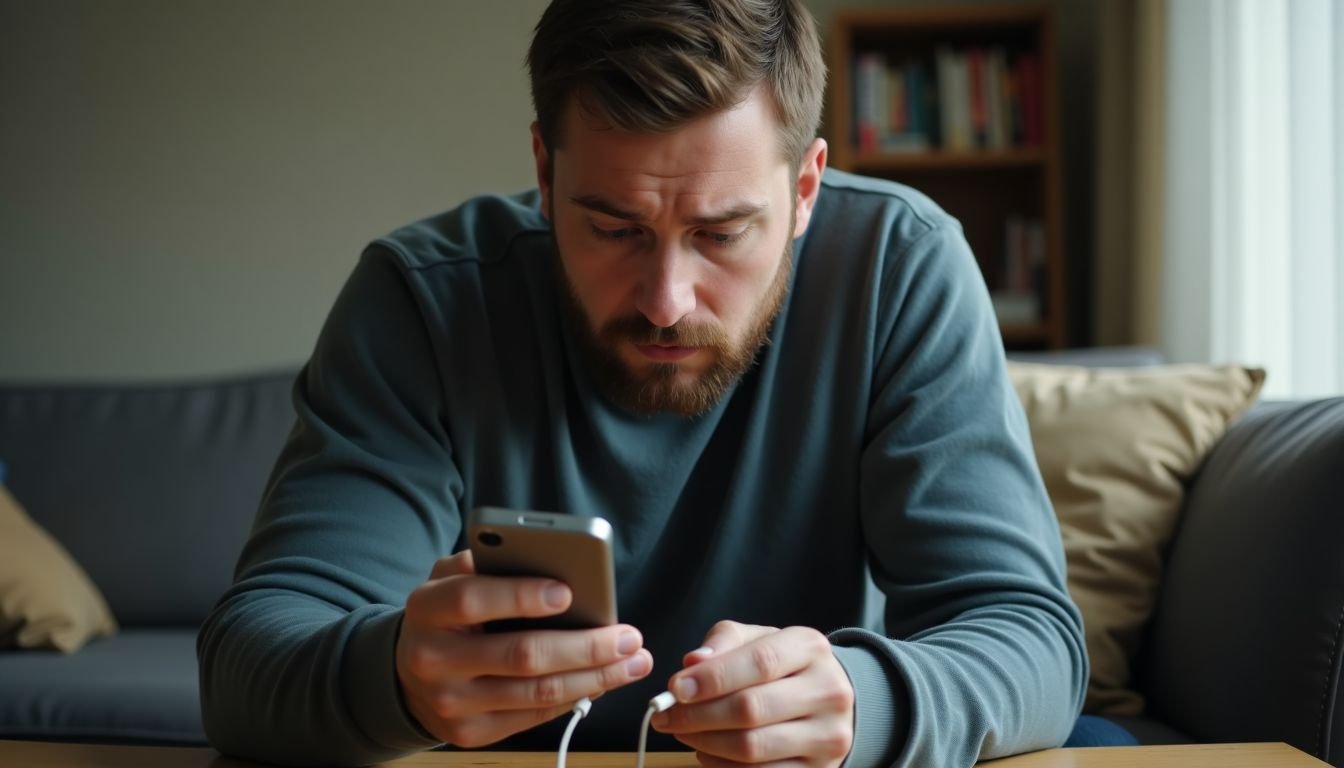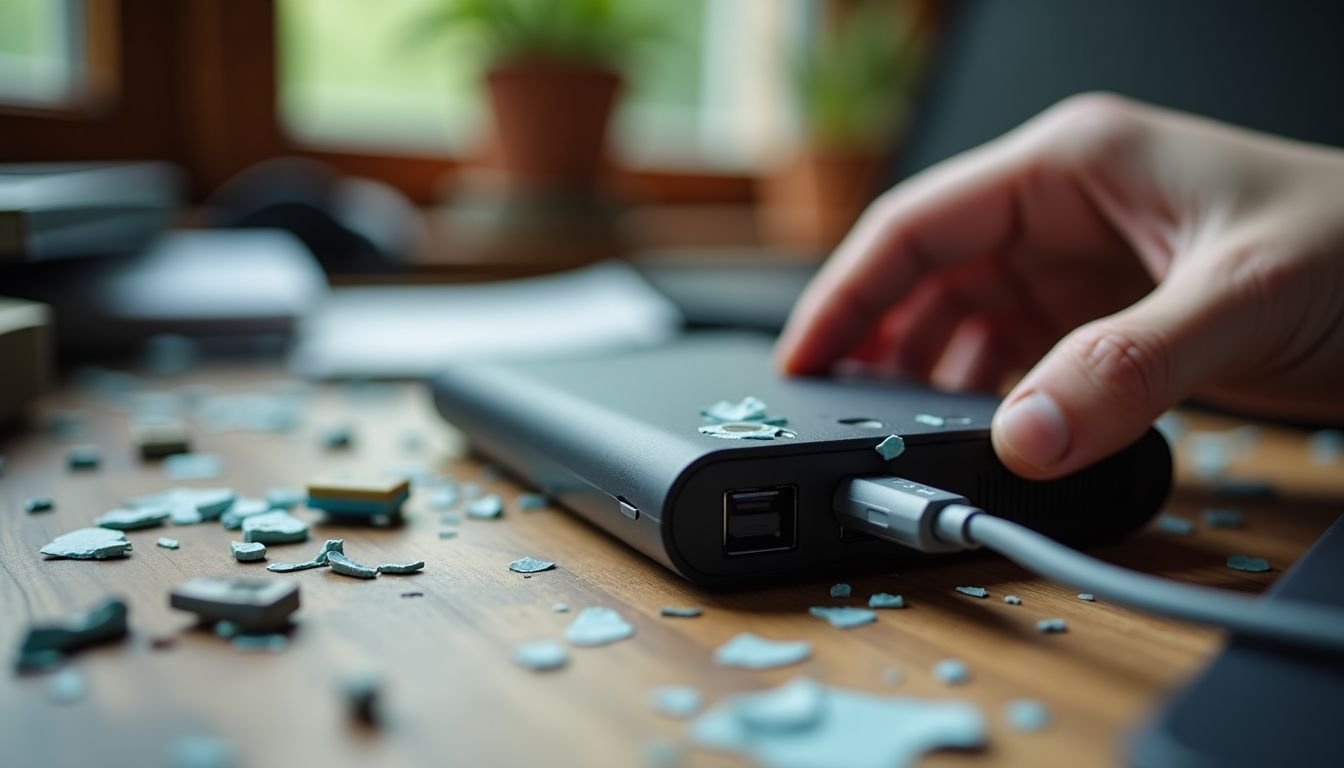Troubleshooting Power Bank Problems – Get Your Battery Back to 100%!

Is your power bank not charging your phone anymore? Power banks can lose their efficiency over time. This article will guide you through fixing common issues, helping to get your battery back to 100%.
Keep reading for helpful tips!
Key Takeaways
- To fix charging issues with your power bank, start by checking the cable and ports for damage. Switching chargers can also solve many problems.
- A power bank that doesn’t hold a charge might need a battery replacement or a reset. High temperatures negatively affect the battery’s performance.
- Physical damage like cracks or loose connections can lead to charging problems. Handle your device carefully to avoid such issues.
- Resetting your power bank involves disconnecting devices, pressing the reset button with something small like a paperclip, and then charging it fully before use again.
- For maintaining your power bank in top condition, regularly clean ports, avoid extreme temperatures, store it properly, and seek professional help when necessary.
Understanding the Basics of a Power Bank

A power bank stores energy from an outlet and transfers it to your devices when needed. It consists of rechargeable batteries that deliver portable power, making charging on the go easy.
How Does a Power Bank Work?
A power bank stores energy from a wall outlet and provides it to your devices. Inside, lithium-ion batteries capture the electrical energy. When you connect your phone or tablet, the power bank transfers this stored energy through USB ports.
Power banks come with vahttps://darrelaffiliate.com/wp-content/uploads/2024/12/vintage-electrical-and-electronic-appliances-in-an-2023-11-27-05-10-10-utc-e1734923695564.jpgus capacities, measured in milliamp hours (mAh). A higher capacity means more charge for multiple devices. Charging problems can arise if connections are loose or cables are damaged.
Understanding these basic functions helps troubleshoot common power bank issues effectively.
Common Issues with Power Banks
Many users experience problems with their power banks. Understanding these common issues helps you troubleshoot effectively.
- Power bank not charging phone. Sometimes, the cable or connection gets loose. Check your charger and make sure it fits securely.
- Not holding charge. This problem often indicates battery aging. A worn-out battery loses its ability to retain energy.
- Power bank not turning on. Faulty buttons or internal damage can cause this issue. Look for physical signs of wear or corrosion.
- Rapid battery charge drop. This issue occurs when the power bank cannot maintain a stable output. High temperatures or defective batteries might lead to this problem.
- Power bank charging problems present themselves as slow or inconsistent charging speeds. Often, the problem lies within the power supply or cable quality.
- Physical damage also affects performance. Cracks, dents, or water exposure can harm internal components and affect functionality.
Each of these issues requires a different approach for troubleshooting your power bank problems effectively. Next, we’ll look at steps to reset your device and restore its functionality.
Troubleshooting Common Power Bank Problems

Power banks can run into several issues that leave you frustrated. From improper charging to a lack of power retention, these problems require quick solutions to get your device back on track.
Not Charging Properly
Power banks often fail to charge properly. This problem can stem from vahttps://darrelaffiliate.com/wp-content/uploads/2024/12/vintage-electrical-and-electronic-appliances-in-an-2023-11-27-05-10-10-utc-e1734923695564.jpgus reasons like a faulty cable or a damaged port. Check the charging cable first. A frayed wire or bent connectors could interrupt the flow of power.
Next, inspect the USB port on both your charger and device for any debris or damage.
Sometimes, users experience issues with battery health and capacity over time. Temperature can also play a role; extreme heat or cold affects performance too. If you find that your power bank still won’t charge after these checks, consider troubleshooting charging solutions like trying different outlets or cables.
In my experience, switching to another charger usually resolves many problems related to power bank charging issues quickly.
Not Holding Charge
A power bank that does not hold a charge frustrates users. Several reasons cause this issue. Over time, batteries lose their capacity to retain energy. A battery’s health may decline due to frequent use or improper charging habits.
Significant temperature changes can also affect performance. If the device charges but drains quickly, it needs troubleshooting.
Start by checking the charging cable and port for damage. Dirt and debris can prevent proper connections too. Ensure you use a compatible charger for your power bank model. Consider replacing old batteries if they show clear signs of wear.
Next, explore steps to reset your power bank effectively.
Physical Damage
Physical damage often leads to problems with your power bank. Drops and impacts can crack the casing or harm internal components. This damage may cause the device not to charge properly or stop working entirely.
Visible dents or scratches point to potential issues inside your power bank.
In many cases, a damaged port affects charging capabilities. If you notice loose connections at the USB port, this could prevent proper functioning. I once had a portable charger that failed after dropping it on concrete.
After inspecting it, I found the charging port was broken, which led me to explore power bank repair at home options. Taking care of your device helps maintain its battery health and performance long-term.
Steps to Reset Your Power Bank

To reset your power bank, start with some initial checks. Make sure all connections are secure and inspect the device for any visible damage before proceeding with the reset process.
Initial Checks
Initial checks are crucial for troubleshooting power bank problems. These steps help determine the root of any issues before attempting fixes.
- Inspect the charging cable. Look for any visible signs of wear, fraying, or damage. A damaged cable can cause charging device problems and prevent your power bank from working properly.
- Verify the charging port on the power bank. Dust, lint, or debris can block connections. Clean it gently with a soft brush to ensure proper contact.
- Check the charge level of your power bank. Press the button if available to see the battery indicator lights. This shows whether the unit holds charge effectively or not.
- Test different devices with your power bank. Use multiple gadgets for charging to identify if specific devices cause problems or if it’s the power bank itself.
- Examine any physical damage on both the power bank and its ports. Look for cracks, dents, or other signs of wear that could impact functionality.
- Ensure you use a suitable wall adapter for charging your power bank. Not all adapters provide adequate power output, leading to poor performance or charging issues.
- Monitor temperature during use or charging sessions. Excessive heat may indicate battery failure issues and can permanently affect your portable charger’s capacity.
- Review user manuals and manufacturer guidelines for troubleshooting tips related to battery health and usage recommendations specific to your model.
- Confirm firmware updates if applicable for smart power banks; outdated software may lead to performance glitches requiring attention.
- Keep in mind how long you’ve owned your device as rechargeable batteries lose capacity over time due to regular use and age-related factors affecting overall performance.
The Reset Process
After completing your initial checks, you can move on to the reset process. This step often helps fix power bank issues and restores battery health.
- Disconnect all devices from the power bank. Ensure no cables are plugged in to avoid interference during the reset.
- Locate the reset button, if available. Many power banks have a small pinhole for this purpose. Use a paperclip or a similar tool to press it gently.
- Hold the reset button for about 10 seconds. This action usually clears any temporary glitches that cause charging problems.
- Release the button and wait a few seconds before proceeding further. This pause allows the device to recover properly.
- Reconnect your power bank to its charger. After resetting, plug it back into a power source for at least an hour.
- Check LED indicators for charging status. A green light typically means fully charged, while red indicates it’s still charging.
- Test your power bank with devices again. Connect your phone or tablet and see if it now charges properly.
Implementing these steps can help resolve many common battery troubleshooting issues with portable chargers and enhance their performance significantly!
Post-Reset Checks
After resetting your power bank, it’s essential to perform some checks. These steps help ensure your device functions properly and maintains battery health.
- Test the charging cable with another device to confirm it works. A faulty cable may cause charging issues.
- Inspect the power bank’s ports for dirt or debris. Clean any grime using a soft cloth or compressed air.
- Charge the power bank for a full cycle. Plug it in and let it charge completely before testing its performance.
- Use the power bank to charge another device. This allows you to check if it holds a charge effectively.
- Monitor the charging time of your devices. An unusually long charging process can signal underlying issues.
- Check for physical damage on the body of the power bank. Cracks or dents can affect its functionality.
- Look at the LED indicators while charging. They should show clear signs of progress as they light up correctly.
- Assess how quickly your devices recharge using the power bank. A drop in battery capacity indicates potential problems.
Following these steps helps troubleshoot battery issues efficiently. You can enjoy reliable portable charger use by ensuring proper maintenance and care.
Preventive Measures and Maintenance Tips for Power Bank Issues

To keep your power bank in great shape, handle it with care and perform regular maintenance checks. This simple approach can help you avoid many common issues. If you want to protect your investment, make sure to read on for more tips!
Proper Usage and Handling
Using your power bank correctly keeps it working well. Charge your power bank fully before its first use. Avoid exposing it to extreme temperatures, as heat can damage the battery.
Store it in a cool, dry place when not in use.
Handle your power bank with care. Don’t drop or bump it against hard surfaces. Using the right cable makes a difference too. Match the charger’s output with your device’s needs for optimal performance.
Following these tips boosts your battery health and prevents common issues like not holding charge or charging problems.
Regular MaintenanceRegular maintenance keeps your power bank in good shape. Check its condition often. Make sure to clean the ports with a soft cloth to prevent dust buildup. Avoid using damaged cables, as they can harm your device and cause charging issues.
Store your power bank in a cool place. High temperatures can hurt battery health. Charge it fully every few months, even if you don’t use it often. This practice helps maintain battery capacity and prevents performance drops over time.
Follow these tips for solid portable charger care and troubleshooting power bank problems effectively.
When to Seek Professional Help
Power banks can face issues that users cannot fix alone. If your portable charger does not hold a charge after trying reset steps, it’s time to seek professional help. A technician can diagnose problems like battery capacity drop or physical damage.
They possess the tools and knowledge necessary for repairs.
Ignoring warning signs may lead to further damage or even battery failure. Professionals can assess battery health accurately. Don’t hesitate if your power bank shows clear signs of malfunctioning, such as swelling or overheating during use.
Fixing power bank issues quickly helps maintain performance and ensures safety while charging devices.
Conclusion

Troubleshooting power bank problems can feel frustrating. Follow the steps in this guide to get your battery back to 100%. Regular checks and maintenance will keep your charger working well.
If issues persist, reach out for professional help. Stay powered up and ready to go!
FAQs
1. What can cause power bank issues such as the battery not holding charge?
Power bank problems like not holding charge or a drop in battery capacity can be due to poor maintenance, charging malfunctions, or internal battery failure.
2. How do I troubleshoot my power bank if it’s not working?
Troubleshooting power bank issues involves checking for possible causes such as faulty cables, improper charging methods, and assessing your device’s overall battery health.
3. Are there specific tips to prevent portable charger malfunctions?
Yes, proper power bank maintenance includes using correct charging solutions and regularly resetting the device to ensure optimal performance and avoid rechargeable battery concerns.
4. Why is my power bank’s battery capacity dropping?
A drop in your power bank’s battery capacity could be due to overuse without adequate rest pehttps://darrelaffiliate.com/wp-content/uploads/2024/12/vintage-electrical-and-electronic-appliances-in-an-2023-11-27-05-10-10-utc-e1734923695564.jpgds between charges or other underlying hardware issues that need troubleshooting.
5. What are some fixes for a failing portable power pack?
Battery performance troubleshooting might involve resetting the device, using appropriate chargers, and seeking professional help if necessary to get your battery back to 100%.